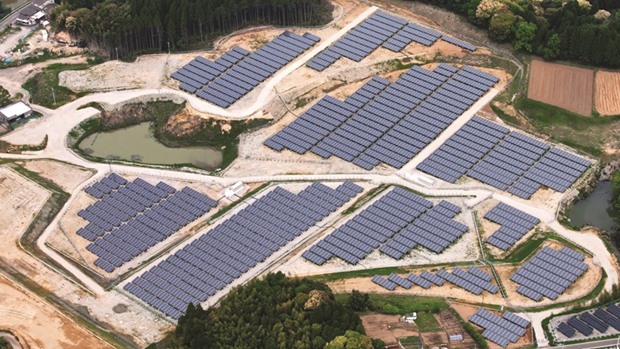With 2.5mn dazzling panels spread across 10 sq km, a giant solar plant in India’s southern state of Tamil Nadu began generating power last month.
The 648-megawatt Kamuthi solar plant, which can provide electricity for 150,000 homes, surpassed California’s 500MW Topaz Solar Farm as the world’s largest solar plant.
But Kamuthi, which is operated by the Adani group and was built at a breakneck pace in just eight months, may not hold on to its title for long.
A 750MW solar park in the central Rewa district is almost complete, and the Delhi metro area is planning to draw power from it by the end of the year.
The projects underline the urgency as well as the lofty goals that India has set as it charts a rapid turnaround from its reliance on fossil fuels towards renewable energy.
It also represents the importance that India, the planet’s third-largest emitter of greenhouse gasses, attaches to fighting the global climate battle.
India, which had around 3GW of installed solar capacity in 2014, built a combined capacity of 9GW last year.
This year the sun-rich country will add 10 more GW, doubling its capacity, said Dilip Nigam, a scientist from the Ministry of New and Renewable Energy (MNRE). India plans to accelerate generation of renewable energy to 175GW by 2022 as part of its commitment to combat climate change.
100GW of this production will be solar energy, illustrating how India has placed solar power at the centre of its energy policy.
Currently, India’s power generation capacity is more than 300GW, with fossil fuels making up the bulk of the country’s energy basket.
“We are increasingly shifting to solar power to run our trains and support infrastructure, like lighting,” said AK Gupta, the electrical director of Delhi Metro.
“Besides drawing 100MW of power from Rewa in future, we already operate rooftop solar power systems that will generate 50MW eventually. Our solar appetite is full,” he said.
India has also positioned itself as a leader of the International Solar Alliance, a bloc of 121 countries that is collaborating to increase solar energy use around the world.
India has become the fourth-largest producer of wind-based electricity, with an installed capacity of 29GW, while unique green energy projects, such as a plant that converts and blocks carbon dioxide emissions, are being established.
But some wonder whether India will be capable of realising its ambitious renewable energy expansion goals.
The 175GW target is challenged by weak infrastructure and lack of financing, a study by the IndiaSpend news and analysis portal shows.
India needs to add more than 130GW of renewable energy over the next six years, at an average of over 21GW annually, which is not realistically achievable, said Vibhuti Garg, an expert at the International Institute for Sustainable Development.
Grid infrastructure and management need to be improved and upgraded or they will prove to be a challenge to India’s renewables programme, said Kanika Chawla from the Delhi-based Council on Energy,
Environment and Water.
“Moreover, two-thirds of jobs in the renewables sector are of a skilled or semi-skilled type.
We need to ensure that there is skill-development training available so it doesn’t cause a slowdown in the sector,” she said.
The Delhi Metro would have bought more solar energy had there been no issues regarding the transmission and storage of solar power, Gupta said, hinting at the challenges.
But environmentalists and officials remain upbeat, citing the falling costs of solar energy amid a surge in demand that could make India a leading renewables market.
“If the demand for electricity continues to rise so quickly, it should not be a problem to achieve our goals,” government scientist Jeevan Jethani said.
“Including construction costs of power plants, green electricity in India is now cheaper than conventional electricity.”
The government appears optimistic as India moves beyond fossil fuels at a pace that seemed impossible a couple of years ago.
India could achieve its climate commitments years ahead of schedule, according to a recently published Draft National Electricity Plan.
The government energy blueprint expects that by 2027, 56.5% of India’s electricity will be produced from clean and renewable sources.
This is a significant increase over the country’s climate goals, which said the country would reach 40% non-fossil fuel electricity by 2030.
The plan also projects no further additions to coal-based capacity between 2022 and 2027.

The 648-megawatt Kamuthi solar plant, which can provide electricity for 150,000 homes, surpassed California’s 500MW Topaz Solar Farm as the world’s largest solar plant.


